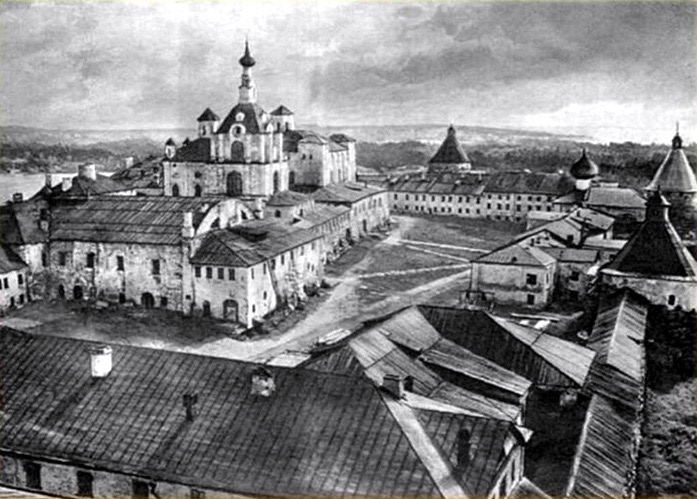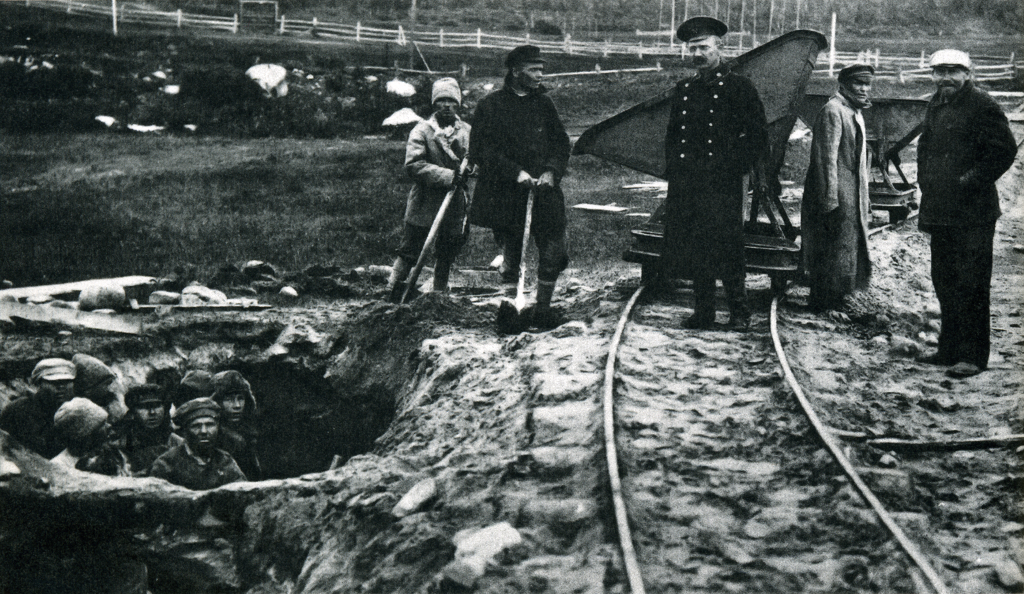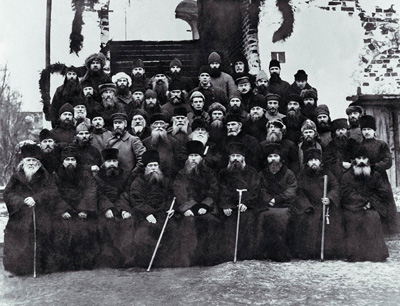Prisoners of the Solovetsky Islands. Part I: Forced Labour, Theatre and Self-Sufficiency in the Soviet Model Camp
Irina Flige has spent 30 years of her life investigating Soviet repressions. In this article she provides an insight into one of the most infamous and unusual Soviet prison camps, located on the territory of a former monastery on the Solovetsky Islands. Part I is dedicated to life in the camp from 1922 to 1929, characterised by self-sufficient administration and a rich cultural life. During that period, the camp resembled a well-functioning community, even if in confinement.
To be published later, part 2 describes how during Stalin’s dictatorship the regime became more brutal and the camp was eventually closed. The camp on the Solovetsky Islands, or “Solovki”, has become the synonym of the criminal Gulag system of the communist regime along with “Vorkuta” and “Kolyma”.
The unusual nature of the concentration camp on the Solovetsky Islands is emphasised by its original name, the Solovki Special Purpose Camp (the Russian abbreviation is SLON), as well as its location in a remarkable geographical region, in the White Sea near the Arctic Circle. This is where the Gulag (Main Directorate of Camps) system was born and developed, to be later used all across the Soviet state. The Solovki camp was the predecessor of and prototype for the whole Soviet camp system. The composition of the detainees and the regime in the camp changed repeatedly over time, along with the general nature of the penitentiary.

Background
From 1920 to 1923, the majority of persons who had been arrested for “counter-revolutionary activities” were taken to several camps in the Arkhangelsk Governorate (in Arkhangelsk, Pertominsk and Cholmogory).
In 1922 the leaders of the GPU (State Political Directorate, predecessor of the NKVD and KGB) came up with the idea of applying much stricter rules of isolation to such detainees. In June 1923 the All-Union Central Executive Committee decided to establish forced labour camps of the GPU on the Solovetsky Islands.
Before the revolution, the islands were famous for the stauropegic Transfiguration Monastery, one of the oldest and most revered Russian Orthodox sanctuaries. In May 1920 the lands of the monastery were confiscated and handed over to the newly-established Solovki state farm. At the same time, a forced labour camp of the Executive Committee of the Arkhangelsk Governorate was founded on the islands and 150-240 detainees were kept in the camp. The monastery was finally closed on 21 July 1923, and its property went to the GPU Directorate of Northern Special Purpose Camps.
The transfer of prisoners from Pertominsk, Cholmogory and Arkhangelsk lasted from the beginning of June to September. In August, the Directorate of Northern Special Purpose Camps was also moved to the islands. Section 1, the largest of the camp, was housed on Bolshoy Solovetsky Island, in the Kremlin of the Solovetsky Monastery main complex, Section 2 in the Savvatiyevo hermitage, 12 km from the village, Section 3 in the hermitage on the island of Bolshaya Muksalma. In addition, the transfer centres on mainland were also subordinated to the camp: one in Arkhangelsk (soon to be closed) and another in Kem, on the Karelian coast.
The GPU (soon to become OGPU) Solovki Special Purpose Forced Labour Camp was established by the 13 October 1923 resolution of the Council of People's Commissars (i.e., the Soviet Government).

1923-1925: Isolation and Self-Sufficiency
Just like the places of isolation for political prisoners, the Solovki camp was subordinated to the OGPU and not to the Main Directorate of Places of Confinement of the People's Commissariat for Justice. According to the statutes of the Solovki camps approved on 3 March 1924 by the OGPU Collegium, the camp was intended for “especially dangerous state criminals, both ordinary criminals and political offenders who could cause material damage to the tranquillity and integrity of life in the Soviet Union with their acts”.
During this period the detainees were completely isolated on the islands and the camp was entirely self-sufficient. All activities were aimed at meeting the needs of the inmates (growing agricultural produce, fishing, getting firewood etc). The principle of self-service even applied to guarding and security: the prisoners guarded the prisoners.
The total number of detainees increased: it was 2,500 at the end of 1923, 5,000 at the end of 1924 and 8,000 in 1925.
- Ordinary criminals, i.e., “thugs”;
- Persons convicted of various domestic and economic criminal offences or for criminal official misconduct;
- “Counter-revolutionaries” (CR), convicted for various “counter-revolutionary” offences: from participants in political and military resistance against the Bolsheviks to monarchist Cadets, as well as persons who were not directly engaged in a political battle against the new regime, but who did not display loyalty towards it or who were suspected of such sentiments;
- “Churchmen”, i.e., clergymen and laymen of various denominations, who were convicted for “religious counter-revolutionary activities”. “Churchmen” were kept together, but separated from others, and they maintained some privileges, e.g., the right to hold services (the Orthodox believers had services in the Onufri Church, located right next to the Kremlin and the only place of worship that remained open after the monastery was closed; the Catholics worshipped in the St Herman Chapel, about three kilometres from the Kremlin), the right to perform other religious rites, keep their long hair and beards, wear a ryasa (cassock), keep icons and icon lamps in their cells.
- Political prisoners (“politicians”): members of “anti-Soviet” socialist parties (Essers, Mensheviks etc) and anarchist groups. They were closely guarded, kept strictly isolated from other categories in former hermitages: the Savvatiyevo hermitage and the hermitage on Bolshaya Muksalma, later on Anzersky (Anzer) Island (so-called political hermitages).

Unlike detainees belonging to other categories, who were almost free to move around the Bolshoy Solovetsky Island, the “political prisoners” were forbidden to leave the hermitage, they were guarded by the military and were locked up for the night.
However, the political prisoners had some privileges – they were not made to work, they had their own self-government bodies (councils of elders), which organised life in the hermitages and maintained relations with the camp administration.
1925-1929: Business, Self-Sufficiency, Cultural and Religious Life
At the beginning of this period the Solovki camp carried out first transfers to the mainland, namely to Karelia. No later than in 1926 the Vishera Division of the Solovki camp (later known as Visherlag) was established in the Central Urals and some time before 1930 the Svir Department (later known as Svirlag) opened in the Leningrad Oblast. In 1928 the Solovki camp administration was relocated to the town of Kem in Karelia.
As a result of the newly established departments on the mainland and the transfers to those departments the total number of prisoners reached 65,000 by 1929/1930, but the population of detainees on the islands remained between 10,000-15,000.
Some of the prisoners were lucky to escape abroad. It was mainly the memoirs and testimonies of the escapees of the time that helped the outside world learn about Solovki. The name “Solovki” became a symbol of Soviet terror and forced labour; the names “Kolyma” and “Vorkuta” replaced it only later.
The Solovki prisoners were used for road construction and loading works in Karelia, logging and erecting industrial buildings in Vishera, railroad construction in the Murmansk region and harvesting firewood for the City of Leningrad in Svir. The export of timber from Karelia turned out to be the most lucrative business for OGPU.
On the Solovetsky Islands the detainees were engaged in building and running the railroad network, logging, extracting iodine and agar-agar from seaweed and hunting marine animals. They worked in fishing cooperatives, agricultural farms, saltworks, fur, leather and craft workshops, brick and lime factories, mechanical engineering works, tar burning and rendering factories.
Some of these undertakings were producing more than just for self-supply, e.g., the brick factory, iodine extraction, fur workshops, timber industries. Naftali Frenkel, a prisoner himself, made a proposal to establish the Economic-Commercial Department at the Solovki camp and became its manager. The purpose of the department was to make more efficient use of free labour on the resource rich islands.
During the second half of the 1920s the Soviet cultural and research institutions were subjected to a thorough purge and repressions were carried out against “anti-Soviet” and “ideologically alien” intelligentsia. Therefore, many intellectuals were taken to Solovki, resulting in fairly unusual initiatives in the camp.
During those years, the Solovetsky Department of the Arkhangelsk Society for Local Lore (SOAOK) pursued active and fruitful activities.
The Society for Local Lore had four sections: history and archaeology section, criminology section (there were abundant sources on the islands for social and cultural studies of the criminal world), hunting section and natural history section (with a plant nursery and tree nursery, agricultural lab, bio station, entomology lab and farm for fur animals).
In addition, the society had a decent library (developed on the basis of the library of the monastery) with about 90,000 books and a museum of local lore. The latter was established to protect the sacral architecture of the islands. “SOAOK Proceedings”, a local lore journal was published from 1924-1927, and some of its articles remain topical even today.
The Solovki camp had its own publishing house and printing shop. They published the journal “Solovetskije Ostrova” (1924-1926 and 1929-1930) and a weekly paper “Novõje Solovki”, with supplements “Solovetski Krokodil”, “Solovetski bezbožnik” and “Radio-Solovki”, which were not published on a regular basis.
The period 1925-1930 was the hey-day of the camp theatre. The performers were inmates, mostly professional actors and musicians.
During the second half of the 1920s Solovki became one of the most important religious centres for the Russian Orthodox Church, for at least 30 important members of the clergy were among the prisoners. Unofficially they were called the Solovetsky Bishops’ Council.
The writings they produced during 1927-1929 were meant for both the clergy and laymen and they were widely spread outside the camp as well. Four of those, known as the “Letters of the Solovetsky Bishops” or “Letters of the Solovetsky Oldies” played an extremely important role in the disputes between the Sergianists (e.g., ardent supporters of the 1927 Declaration by Metropolitan Sergius) and anti-Sergianists.
Irina Flige (born in 1960) started investigating the repressions in the Soviet Union as early as the late 1980s. Since 2002 she has been Director of the Memorial Research & Information Centre in St Petersburg. Flige has played an important role in discovering and researching the burial sites of victims of communism in Russia. For example, Flige and her colleagues discovered the secret site in Sandarmokh where victims of Stalin’s Great Terror had been buried.
Sources and Literature:
Бродский Ю.А. Соловки. Двадцать лет Особого назначения. – М.: 2008. – 528 с., ил.
Флиге [Резникова] И.А. Православие на Соловках. Материалы по истории Соловецкого лагеря. – СПб.: Издательство Научно-информационного центра «Мемориал», 1994. – 208 с.
Сошина А.А. На Соловках против воли: судьбы и сроки. 1923–1939. – Соловки; М.: «Издательство ТСМ», 2014. – 232 с. :ил.
Флиге И.А. Сандормох: драматургия смыслов. – СПб.: Нестор-История, 2019. – 208 с., ил.
Система исправительно-трудовых лагерей с СССР, 1923–1960: Справочник / О-во «Мемориал», ГАРФ. Сост. М.Б. Смирнов. Под ред. Н.Г. Охотина, А.Б. Рогинского. М: Звенья, 1998. – 600 с., карт. (Беломоро-Балтийский ИТЛ. – С.162-164; Соловецкий ИТЛ ОГПУ – С.394-397)
Memoirs:
Волков О. Погружение во тьму. Из пережитого. – Paris: Atheneum, 1987. – 447 p.
Чирков Ю.И. А было все так… – М.: Политиздат, 991. – 99. – 382 с.: ил.
Безсоновъ. Двадцать шесть тюремъ и побҌгъ съ Соловковъ. – Издание Imprimerie de Navarre (5, rue des Gobelins, Paris), 1928. – 228 стр.
Генерал-майор И.М.Зайцев. Соловки (коммунистическая каторга, или мҌсто пыток и смерти). Из личных страданiй, переживанiй, наблюденiй и впечатлҌнiй. В двух частях. (С приложенiем четырех планов.) – Шанхай, 1931 г. Типографiя издательства «Слово». – 169 стр.
Мих.Розанов. Соловецкий концлагерь в монастыре. 1922–1939 годы. Факты – домыслы – «параши». Обзор воспоминаний соловчан соловчанами. В двух книгах. Книга первая. Издание автора. 1979. [Место издания не указано, автор жил в США].
М.З.Никоновъ-Смородинъ. Красная каторга (Записки соловчанина) / Подъ редакцiей А.В. Амфитеатрова. – Софiя, Издательство Н.Т.С.Н.П., 1938 г. – 369 стр.
С.Пiдгайний. Украïнська iнтелiгенцiя на Соловках. Спогади 1933–1941. – Мюнхен: издательство «Прометей», 1947. – 93 стр.
Vladimir V. Tchernavin. I speak for the Silent. Prisoners of the Soviets. – Boston & New York, 1935. – 368 стр.
Г.Андреев. Соловецкие остров